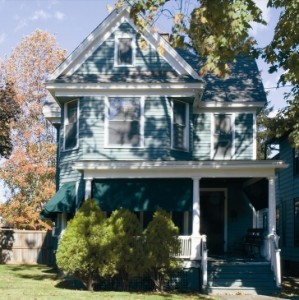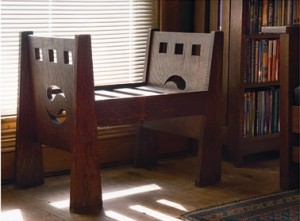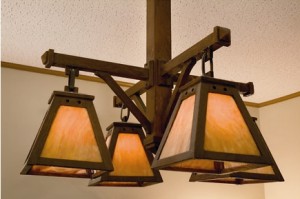By David Cathers
 Collecting American Arts and Crafts furniture in the early 1970s was simple and straightforward. You searched and searched and searched, and when you were lucky enough to find, say, an actual piece of Gustav Stickley furniture, you’d buy it, almost no matter what. Unless you tallied up the expense of driving many thousands of miles year after year, it didn’t cost much money, because in those days almost nobody wanted that furniture. Established antiques dealers looked down their noses at such 20th-century “junk.” By about 1980, though, prices for Gustav Stickley furniture began their inexorable rise, and since the late 1980s they’ve occasionally reached stratospheric heights.
Collecting American Arts and Crafts furniture in the early 1970s was simple and straightforward. You searched and searched and searched, and when you were lucky enough to find, say, an actual piece of Gustav Stickley furniture, you’d buy it, almost no matter what. Unless you tallied up the expense of driving many thousands of miles year after year, it didn’t cost much money, because in those days almost nobody wanted that furniture. Established antiques dealers looked down their noses at such 20th-century “junk.” By about 1980, though, prices for Gustav Stickley furniture began their inexorable rise, and since the late 1980s they’ve occasionally reached stratospheric heights.
During the first years of the 1970s there was other Arts and Crafts furniture you searched for, too, mostly Roycroft, L. & J.G. Stickley, Stickley Brothers and Limbert. On the East Coast, we combed New York State for the work of Charles Rohlfs. Others hunted for the decorative designs of Frank Lloyd Wright and, on the West Coast, a handful of collectors sought Greene and Greene. Beyond those, a few large-scale makers were known then, for instance the Michigan furniture firms Lifetime and Luce, the Cincinnati-based Shop of the Crafters, New York’s Joseph P. McHugh and a smattering of others.
But beyond these re-emerging names lay a baffling terra incognita of unidentified furniture that collectors, dealers and auction houses came to label “generic mission.” While it’s unlikely that we’ll ever know exactly how much of that furniture was made, for 10 or 15 years it poured out of American factories in huge quantities: A 1908 industry survey, for instance, listed 148 manufacturers specializing in “mission furniture.” Though often it was pretty scrappy stuff, many pieces were well designed, solidly constructed and nicely finished. Clearly there had once been a number of manufacturing firms, their names long lost, that had produced this furniture with considerable care. For many modern-day Arts and Crafts enthusiasts, this vast landscape remained unknown territory until the pioneering husband-and-wife team of Michael Clark and Jill Thomas-Clark ventured into it about 1988.
Michael, a professor of speech and theater at Elmira College in Elmira, N.Y., and Jill, registrar of the Corning Museum of Glass in nearby Corning, began buying American Arts and Crafts when they married and moved to Elmira in 1984-deciding, reasonably, that they should collect something they both liked. Together they have built their collection of Arts and Crafts furniture, lighting and textiles over the last two decades, making most of their finds in small-town auctions scattered across New York State. They’ve also branched out, buying Onondaga Pottery dinnerware made in Syracuse in the early 1900s,
Belgian and American art pottery, Russel Wright dinnerware from the 1930s and ‘40s, Maxfield Parrish prints, and copper and aluminum artware hand wrought by the Avon Coppersmith. The two, with graduate degrees in the arts and art history, became eclectic and knowledgeable collectors, buying what they liked, what they wanted to research and what they could use in their 1905 Arts and Crafts-era home. They have never held on to pieces solely because they are rare or unique. As Jill says, “We have always kept the things we like to live with. We preserve and protect the furniture we collect, but we also use it.” They’e said they would rather have a roomful of Arts and Crafts furniture than “one piece of Gus.”
 In their career they’ve mapped a whole territory of previously unknown or little-known New York State Arts and Crafts furniture makers-about 50 so far. These firms- whose work had been relegated to the dim reaches of the “generic mission” universe until the Clarks identified and wrote about them- have become familiar names to Arts and Crafts enthusiasts. Among them are Plail Brothers Chair Company, in Wayland; Majestic Chair Company, in Herkimer; Quaint Art Furniture Company, in Syracuse; H.C. Dexter Chair Company, in Black River; and the Stickley & Brandt Company, in Binghamton. The Clarks have profiled these and other makers in their much read “Best of the Rest” series in Style 1900 magazine. In 1999, at Hamilton College, in Clinton, N.Y., they curated “Imitation and Innovation: An Evaluation of Arts and Crafts Furniture in Central New York,” the first-ever museum exhibition of the furniture once known only as “generic mission.”
In their career they’ve mapped a whole territory of previously unknown or little-known New York State Arts and Crafts furniture makers-about 50 so far. These firms- whose work had been relegated to the dim reaches of the “generic mission” universe until the Clarks identified and wrote about them- have become familiar names to Arts and Crafts enthusiasts. Among them are Plail Brothers Chair Company, in Wayland; Majestic Chair Company, in Herkimer; Quaint Art Furniture Company, in Syracuse; H.C. Dexter Chair Company, in Black River; and the Stickley & Brandt Company, in Binghamton. The Clarks have profiled these and other makers in their much read “Best of the Rest” series in Style 1900 magazine. In 1999, at Hamilton College, in Clinton, N.Y., they curated “Imitation and Innovation: An Evaluation of Arts and Crafts Furniture in Central New York,” the first-ever museum exhibition of the furniture once known only as “generic mission.”
All that is not to say that they have ignored Stickley. In 2002 they published The Stickley Brothers, the sole book that charts the personal and professional interactions of Gustav, Leopold, Albert, Charles and John George. They are regulars at the Grove Park Inn conference, where they lead small-group discussions each year. In 2002, they revealed some of their trade secrets in a session on their adventures as “Arts and Crafts Sleuths,” and in 2005 they lectured on a topic close to the heart of everyone at the conference (and certainly many readers of this magazine): “From William Morris to Archie Bunker: The Evolution of the Morris Chair.”
Beyond “Generic Mission”
 When they began collecting in earnest, they knew, as art historians and researchers, that they could not long be satisfied with such a vague designation as “generic mission” for the furniture turning up at country auctions. They needed to learn more about this little-explored landscape and its inhabitants.
When they began collecting in earnest, they knew, as art historians and researchers, that they could not long be satisfied with such a vague designation as “generic mission” for the furniture turning up at country auctions. They needed to learn more about this little-explored landscape and its inhabitants.
Perhaps providentially, it was an unusually well designed and beautifully made slat-backed armchair they found at a local auction in 1988 that provided a case study, as it were, for their education.
The maker of the chair (which they snapped up for $35) was unknown. The only clue, and it was a tantalizing one, was a fragmentary oval black paper label on the underside printed with ornate gold script that was no longer legible. It wasn’t until the following year, at the 1989 Grove Park Inn Arts and Crafts Conference, that they found a dealer who had an identical chair with an intact label. It read “J.M. Young & Sons. Camden, New York.” As Michael recalls, “I remember walking into the room at the antique show and looking to my left, and our same chair was on a table. I walked/rushed to it and flipped it up and there was the J.M. Young & Sons oval label.”
J.M. Young furniture was attracting a few collectors by then because it offered a Stickley-like level of craftsmanship at less-than-Stickley prices. But little was known about it. Who was J.M. Young? When did this firm produce Arts and Crafts furniture, and how much had been made? And what had become of the company?
Though at this point they had many questions and few answers, that single, intact paper label was the catalyst for their journey of discovery into the world of “generic mission.”
Discovering J.M. Young
As the first step of their research into J.M. Young, Jill contacted the Historical Society of Camden, N.Y. She immediately experienced one of the incredible strokes of good luck that seem to come most often to dedicated and resourceful researchers: the woman she reached, one of the society’s volunteers, knew the firm well because her husband had been its last owner, and- astonishingly- she still had its surviving records in her possession. Just before the old Young factory was to be demolished in 1979, she and her husband had retrieved as many of the firm’s papers as they could find. They packed them into cardboard boxes and stored them away, hoping that someone, one day, would consider them important.
Offering to research and interpret this trove and ultimately donate it to Winterthur-the preeminent decorative arts museum and library in Winterthur, Delaware-the Clarks brought the boxes home. They had in their hands the firm’s sales journals, letters and furniture photos, as well as facts about construction techniques, woods, stains and finishes. They excitedly pulled from the boxes two small books, more precious to a researcher than gold: shop drawings containing, as they later wrote, “measurements and design changes handwritten by J.M. and [his son] George Young.”
They also retrieved other crucial details of the shop’s Arts and Crafts work, including records showing the dates when specific armchairs, rockers and tables were first made, how many of each model were sold and when they were dropped from production. (Among their discoveries was that the chair that had started it all was a #1916 armchair, made in 1927.) And, intent on gathering the kind of direct, firsthand insights that can’t be gleaned from business papers, they found and talked with the factory’s few surviving workers and befriended J.M.’s grandson, Gordon. Studying those dusty documents and arranging personal interviews gave the Clarks an intimate view of the firm’s day-to-day operations during the years-a surprisingly long span of them, as it turned out-when J.M. Young & Sons made Arts and Crafts furniture.
In 1994 they shared their discoveries with other collectors and scholars in their first book, J.M. Young Arts and Crafts Furniture, still the definitive source of information on the firm’s work. John McIntosh Young, they had learned, was a Scottish immigrant, a woodcarver who opened his furniture manufacturing business in 1872, in Camden, about 30 miles northeast of Syracuse, and began making elaborate Victorian chairs, tables and cabinets, along with more utilitarian, bread-and-butter furniture. His was a small, family-run enterprise, with J.M. and his sons busy each day in their factory alongside a workforce of some 12 to 14 men.
In 1902, the company abruptly changed direction and began producing Arts and Crafts furniture influenced by Gustav Stickley and L. & J.G. Stickley in addition to its original designs. Though it was organized like most other American furniture manufacturers of its day and had an efficient factory equipped with up-to-date machinery, it added an extra dimension of handicraft. As Jill and Michael have written, “In identifying the works … one will find the diversity of the artist craftsman at work. J.M. Young, his sons and collective of craftsmen, working in the spirit of the Arts and Crafts movement, often made design modifications on the spot to create an individualized piece.”
 The Clarks’ research revealed surprising and significant facts about J.M. Young. They learned that when Leopold Stickley’s company stopped making Arts and Crafts furniture, about 1922, he at first filled orders from stock on hand, then turned to the Youngs to replicate several of his most popular models and recreate his fumed finishes. In other words, some ÒL. & J.G. Stickley furniture- was in fact made by J.M. Young. Young continued manufacturing these designs on a limited basis into the 1940s-startling evidence that in some instances “mission” furniture making continued much longer than is commonly believed.
The Clarks’ research revealed surprising and significant facts about J.M. Young. They learned that when Leopold Stickley’s company stopped making Arts and Crafts furniture, about 1922, he at first filled orders from stock on hand, then turned to the Youngs to replicate several of his most popular models and recreate his fumed finishes. In other words, some ÒL. & J.G. Stickley furniture- was in fact made by J.M. Young. Young continued manufacturing these designs on a limited basis into the 1940s-startling evidence that in some instances “mission” furniture making continued much longer than is commonly believed.
Today, Jill and Michael are not just scholarly chroniclers of J.M. Young. They are ardent collectors who’ve filled their home with the firm’s best Arts and Crafts furniture, a unique collection their passion for research has helped to shape.
Who Made All Those Brown Oak Lamps?
The Clark home is also the showplace for another of their passions, a large collection of “mission” table lamps-about 50-that has grown out of their exploration of the mysteries of Arts and Crafts lighting. A common sight in American homes a hundred years ago and frequently seen in collections today, these lamps are mostly straight-lined, made of quartersawn oak stained brown, and have varicolored art glass shades, occasionally leaded but often not. Yet as familiar as these lamps are, their origins have long perplexed collectors. Though some were evidently shop-class projects produced by students and others the efforts of amateur woodworkers, most were clearly factory made.
But what factory? Probably there were several manufacturers, and their names are still obscure. When the Clarks came across a rare 1912 catalog, though, something clicked, and they presented their major discovery at the 2001 Grove Park Inn Conference in a lecture that asked, “Who Made All Those Brown Oak Lamps?” The answer turned out to be-yes-the W.B. Brown Company, of Bluffton, Ind., a manufacturer that touted its wares with the hearty, self-confident slogan, “A Firm with A Mission.”
As Jill and Michael discovered, the forgotten Mr. Brown created light fixtures that were “designed and constructed to blend harmoniously with the total Arts and Crafts environment.” In Style 1900 they wrote that he used “efficient design and production methods” that made his stylish lighting affordable and “easily shipped in great quantities.” Brown’s factory relied on machine power to mass-produce table lamps and ceiling lights, but the products were also marked by handcraftsmanship of its highly skilled staff: “the artistry of individual workers,” as the Clarks wrote, “remains evident in each fixture.” Like J.M. Young and the other Arts and Crafts furniture makers uncovered by their research, Brown helped popularize the movement and brought its “modern” idea of simple design to a large and appreciative middle-class market. A book on Arts and Crafts lighting, focusing on Brown and many other makers, will be the Clarks’ next project.
The Furniture in the Attic
These pioneering scholars and collectors hope in the years ahead to devote even more time to the Arts and Crafts subjects that matter to them most. “We write only what we want to write,” they told me. “It is a labor of love.” Though they live mainly with J.M. Young furniture and W.B. Brown lamps, they also have a “study collection” stored in their attic. I haven’t had a chance to explore that attic, and I’m curious: just what, exactly, is up there? And, whatever it is, who designed and made it? One day, I expect, the Clarks’ ongoing labor of love will produce more answers.
Tags: Brown, Corning, Elmira, furniture, Greene, Greene and Greene, J.M. Young, Limbert, Morris, New York, Roycroft, Stickley, William Morris



Hello I recently acquired an original finish Quaint Art Furniture Co. rocker with the makers label intact and in excellent condition I would like to learn more about this well made chair loaded with pegs and nice tenons Can anyone tell me its approx age? And where I might find more information on the Companys designs Thank you Joe Troup
Thank you for information on my Quaint Furniture Co. Rocker
I recently was willed a mission chair from an aunt that lived in camden ny. On the bottom of the chair it has a stamp on it saying it was made in camden ny. Can you tell me if its from the young company and about how old it is
You may want to submit your question with a good quality photo to David Rudd, American Bungalow antiques expert. Include as much info as you have about the piece, and send it to editors@ambungalow.com.
My family has a chair with HC Dexter on the
Bottom. It has what spear to be musketeer
Painted on the front Cam you or direct
Me to information as to who this might be
I have a 5 piece mission set by H. C. Dexter Chair Company, it has been in my family for at least 70 years. It is inlayed with silver, copper and onyx. Can you head me in the correct direction for an appraisal and who would be interested in something like this.
Thank you:
Sarah G.